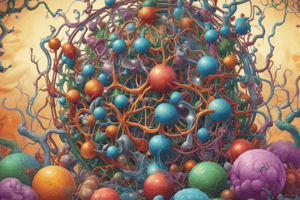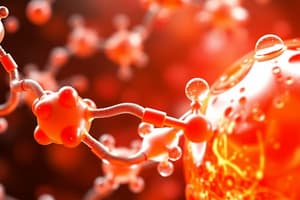Podcast
Questions and Answers
How does the catalytic efficiency of enzymes compare to uncatalyzed biochemical reactions?
How does the catalytic efficiency of enzymes compare to uncatalyzed biochemical reactions?
- Enzymes accelerate reactions by a factor of $10^5$ at most.
- Enzymes slow down biochemical reactions to maintain cellular metabolism.
- Enzymes can accelerate biochemical reactions by up to $10^{17}$-fold. (correct)
- Enzymes accelerate reactions to a similar degree as other chemical catalysts.
What distinguishes coenzymes from other types of cofactors?
What distinguishes coenzymes from other types of cofactors?
- Coenzymes are proteins, while other cofactors are non-proteinaceous.
- Coenzymes are organic molecules, while other cofactors can be inorganic or organic. (correct)
- Coenzymes are permanently bound to the enzyme, while other cofactors are loosely bound.
- Coenzymes are inorganic molecules, whereas other cofactors are organic.
What is the role of a cofactor in enzyme function?
What is the role of a cofactor in enzyme function?
- To provide structural support to the enzyme.
- To increase the biological activity of the enzyme. (correct)
- To inhibit the enzyme's activity.
- To protect the enzyme from denaturation.
An apoenzyme, on its own, is best described as:
An apoenzyme, on its own, is best described as:
What is the expected outcome if enzymes were entirely absent from a biological system, such as the human body?
What is the expected outcome if enzymes were entirely absent from a biological system, such as the human body?
Which statement accurately describes the relationship between an apoenzyme, a cofactor, and a holoenzyme?
Which statement accurately describes the relationship between an apoenzyme, a cofactor, and a holoenzyme?
Consider a biochemical reaction that normally takes 2 seconds with enzymatic catalysis. If the enzyme accelerates the reaction by $10^{12}$-fold, approximately how long would the same reaction take without the enzyme?
Consider a biochemical reaction that normally takes 2 seconds with enzymatic catalysis. If the enzyme accelerates the reaction by $10^{12}$-fold, approximately how long would the same reaction take without the enzyme?
If a scientist discovers a new molecule that binds to an enzyme and is essential for its activity, but it is not a protein, how would this molecule be classified?
If a scientist discovers a new molecule that binds to an enzyme and is essential for its activity, but it is not a protein, how would this molecule be classified?
How does the presence of enzymes affect the equilibrium of a biochemical reaction?
How does the presence of enzymes affect the equilibrium of a biochemical reaction?
Why is the classification of RNA and antibodies as ribozymes and abzymes, respectively, significant in biochemistry?
Why is the classification of RNA and antibodies as ribozymes and abzymes, respectively, significant in biochemistry?
How did Eduard Buchner contribute to the field of enzymology?
How did Eduard Buchner contribute to the field of enzymology?
Which statement accurately describes the role of enzymes in metabolic processes?
Which statement accurately describes the role of enzymes in metabolic processes?
Consider an experiment where an enzyme's activity is being measured under different conditions. Which factor would NOT directly influence the enzyme's catalytic rate?
Consider an experiment where an enzyme's activity is being measured under different conditions. Which factor would NOT directly influence the enzyme's catalytic rate?
What is the most accurate interpretation of the 'lock-and-key' principle in the context of enzyme function?
What is the most accurate interpretation of the 'lock-and-key' principle in the context of enzyme function?
Which of the following is a historically significant application of enzymes that predates the formal scientific study of enzymology?
Which of the following is a historically significant application of enzymes that predates the formal scientific study of enzymology?
James B. Sumner's crystallization of urease was significant because it provided evidence that:
James B. Sumner's crystallization of urease was significant because it provided evidence that:
Considering the properties of enzymes, in what scenario would the use of enzymes be most advantageous compared to traditional chemical catalysts?
Considering the properties of enzymes, in what scenario would the use of enzymes be most advantageous compared to traditional chemical catalysts?
In the context of enzyme evolution, what advantage did the development of enzymes confer upon early life forms?
In the context of enzyme evolution, what advantage did the development of enzymes confer upon early life forms?
If an enzyme is described as working 'in vitro', what does this indicate about the location of the enzyme's activity?
If an enzyme is described as working 'in vitro', what does this indicate about the location of the enzyme's activity?
Which statement regarding enzymes is most accurate, considering current scientific understanding?
Which statement regarding enzymes is most accurate, considering current scientific understanding?
Flashcards
Enzymes
Enzymes
Proteins that speed up chemical reactions in living organisms, acting as biological catalysts.
Substrates
Substrates
The specific molecules that enzymes act upon.
Products
Products
Molecules resulted from the enzyme converting substrates.
Enzymology
Enzymology
Signup and view all the flashcards
Anselme Payen
Anselme Payen
Signup and view all the flashcards
Jöns Jakob Berzelius
Jöns Jakob Berzelius
Signup and view all the flashcards
Friedrich Wilhelm Kühne
Friedrich Wilhelm Kühne
Signup and view all the flashcards
Lock-and-key principle
Lock-and-key principle
Signup and view all the flashcards
Eduard Buchner
Eduard Buchner
Signup and view all the flashcards
James B. Sumner
James B. Sumner
Signup and view all the flashcards
Ribozymes
Ribozymes
Signup and view all the flashcards
Cofactors
Cofactors
Signup and view all the flashcards
Apoenzyme
Apoenzyme
Signup and view all the flashcards
Holoenzyme
Holoenzyme
Signup and view all the flashcards
Prosthetic Group
Prosthetic Group
Signup and view all the flashcards
Helper Molecule
Helper Molecule
Signup and view all the flashcards
Biocatalyst
Biocatalyst
Signup and view all the flashcards
Study Notes
- Enzymes are proteins that function as biological catalysts.
- Enzymes accelerate chemical reactions.
- Substrates are the molecules that enzymes act upon.
- Enzymes convert substrates into different molecules known as products.
- Enzyme catalysis is needed for almost all metabolic processes in the cell to occur at rates fast enough to sustain life.
- Metabolic pathways rely on enzymes to catalyze individual steps.
- Enzymology is the study of enzymes.
- Processes based on the action of enzymes, like alcoholic fermentation, use of yeast for baking, and cheese production, have been used for thousands of years.
- The first evidence of enzymes came in 1833 from French chemist Anselme Payen's experiments, using barley seedling extracts to produce large quantities of sugar from starch.
- The existence of a "ferment" was postulated, originating from the Latin term "fermentum," meaning fermentation or leaven.
- In 1830-1840, Swedish chemist Jöns Jakob Berzelius proposed that this ferment had a catalytic effect, on which the process of fermentation was based.
- Friedrich Wilhelm Kühne introduced the term "enzyme" in 1878, derived from the Greek word "énzymon," meaning leaven or yeast.
- Emil Fischer, the 1902 Nobel Prize winner in Chemistry for work on sugar chemistry, postulated the lock-and-key principle in 1890.
- The lock-and-key principle explains a substrate fitting into the active center of an enzyme like a key fits into a lock.
- Eduard Buchner is the founder of modern enzymology.
- Buchner proved that fermentation can occur without living cells, catalyzed by a protein-containing substance called zymase and was awarded the Nobel Prize in Chemistry in 1907.
- James B. Sumner proved in 1926 that the enzyme urease is a pure, crystallizable protein.
- John H. Northrop confirmed this for pepsin, trypsin, and chymotrypsin.
- Sumner and Northrop received the Nobel Prize in Chemistry in 1946 together with Wendell M. Stanley.
- Enzymes can work actively in vitro, which makes them useful in industrial processes.
- Enzymes are nature's own biocatalysts because they are complex protein molecules produced by living organisms to catalyze the biochemical reactions required to sustain life.
- Mostly enzymes are proteins, but RNA and antibodies can also act as catalysts known as ribozymes and abzymes, respectively.
- Literature suggests that enzymes catalyze over 5000 biochemical reaction types.
- Enzymes accelerate biochemical reactions up to 10^17-fold.
- Enzymes maintain the metabolism of all living organisms.
- Most enzymes need a small molecule called cofactors or coenzymes to perform activity as a catalyst.
- Cofactors are non-proteinaceous chemical compounds bound to an inactive protein part of an enzyme, or apoenzyme.
- Cofactors increase the biological activity of the enzyme needed for its function.
- The active complex of apoenzyme (protein part) with cofactor (coenzyme or prosthetic group) is called holoenzyme.
- A cofactor is a "helper molecule" which assists in biochemical transformations.
- Coenzymes and prosthetic groups are the two types of cofactors.
- Coenzymes are a specific type of cofactor and are organic molecules that bind to enzymes and help in their functions.
Studying That Suits You
Use AI to generate personalized quizzes and flashcards to suit your learning preferences.
Related Documents
Description
Enzymes are proteins accelerating chemical reactions as biological catalysts. They act on substrates, converting them into products necessary for metabolic processes. Enzymology, the study of enzymes, reveals their importance in sustaining life and various processes like fermentation and cheese production.




